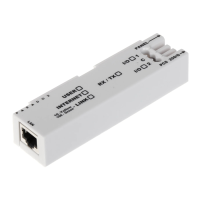
Do you have a question about the Paradox IP150 and is the answer not in the manual?
| Power Supply | 12 VDC |
|---|---|
| Network Interface | Ethernet 10/100Base-T |
| Compatibility | Paradox security systems |
| Reporting | Yes |
| Remote Control | Yes |
| Arming/Disarming | Yes |
| Firmware Upgrade | Yes |
| Supported Protocols | TCP/IP, HTTP, SMTP |
| Humidity | 10% to 90% non-condensing |
Introduction to the IP150 Internet Module's purpose and capabilities.
Details on monitoring system status, troubles, and zones.
Solutions for typical problems encountered with the IP150 module.
Displays hardware and software details of the system and module.
Setup for IP reporting to monitoring stations.
Stores installation and monitoring station details.
Setup for email notifications for system events.
Configures network settings and module parameters.
Manages up to 16 email addresses for notifications.
Details module capabilities and necessary system prerequisites.
Step-by-step guide for physical connection and mounting.
Explains LED status lights and how to reset the module.
Detailed steps for configuring IP reporting to a monitoring station.
Configures how the IP150 monitors the IP line for connection status.
Lists panel compatibility, browser requirements, and certifications.
Steps to configure router port forwarding for external access.
Guides on registering and using the ParadoxMyHome service for dynamic IP access.
Instructions for accessing the system via web browser locally and off-site.
How to define and configure I/O terminals as inputs or outputs.
